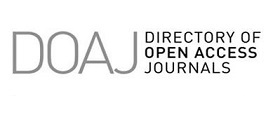Anthropic impacts on forest cover in the Iracá river basin, Colombian plains piedmont
DOI:
https://doi.org/10.30972/geo.22438105Keywords:
watershed, stream, forested corridors, fragmentation, connectivityAbstract
Between August 2023 and September 2024, a study was conducted in the Iracá river basin in the Colombian plains foothills to evaluate the current state of the forests as a function of the land use regime. During this period, two critical variables of anthropogenic impact were measured: fragmentation and loss of connectivity of forest corridors. The study was based on photographic records and field walks and subsequent geospatial analysis with LANDSAT images to establish the degrees of fragmentation of the native forest.
It was found that the forest corridors have suffered some degree of structural fragmentation leaving relicts that show an insular spatial arrangement. Gaps were identified, in some cases greater than 1 kilometer, that cut the continuity of the forest corridors, affecting the biotic flow of fauna and impacting the network of small tributaries, compromising ecosystem functionality.
References
Alaniz, A. J., Smith-Ramírez, C., Rendón-Funes, A., Hidalgo-Corrotea, C., Carvajal, M. A., Vergara, P. M. & Fuentes, N. (2022). Multiscale spatial analysis of headwater vulnerability in South-Central Chile reveals a high threat due to deforestation and climate change. Science of The Total Environment, 849, 157930. https://doi.org/10.1016/j.scitotenv.2022.157930
Bega, J. M., Saltarelli, W. A., Gücker, B., Boëchat, I. G., Finkler, N. R. & Cunha, D. G. (2024). Effects of riparian vegetation restoration and environmental context on ecosystem functioning in tropical streams of southeastern Brazil. Science of The Total Environment, 948, 174906. https://doi.org/10.1016/j.scitotenv.2024.174906
Briceño -Vanegas, G. A. (2015). Evolución de la integridad estructural de ecosistemas lóticos del piedemonte llanero frente a la intervención antrópica. Acta Biológica Colombiana, 20(2), 133-144. http://dx.doi.org/10.15446/abc.v20n2.42307.
Briceño -Vanegas, G. A. (2023). Ecología, conceptos y aplicaciones para Latinoamérica. Alphaeditorial.
Briceño -Vanegas, G. A. y Gallego-Herrera, C. (2023). Ecological Functionality of Forest and Stream Corridors in an Area of the Plains Piedmont in Casanare. Acta Biológica Colombiana, 28(3), 475-485. https://doi.org/10.15446/abc.v28n3.99160
Cadol, D. & Wohl, E. (2010). Wood retention and transport in tropical, headwater streams, La Selva Biological Station, Costa Rica. Geomorphology, 123(1-2), 61-73. https://doi.org/10.1016/j.geomorph.2010.06.015
Castiblanco, C., Etter, A. & Ramirez, A. (2015). Impacts of oil palm expansion in Colombia: What do socioeconomic indicators show? Land Use Policy, 44, 31-43. https://doi.org/10.1016/j.landusepol.2014.10.007
Forman, R. T. T. and Baudry, J. (1984). Hedgerows and hedgerow networks in landscape ecology. Environmental management, (8), 495-510. https://doi.org/10.1007/BF01871575
Forman, R. T. T. (1995). Land Mosaics. The ecology of landscapes and regions. Cambridge University Press. https://doi.org/10.1017/9781107050327.
Gonçalves Jr, J. F. & Callisto, M. (2013). Organic-matter dynamics in the riparian zone of a tropical headwater stream in Southern Brasil. Aquatic Botany, 109, 8-13. https://doi.org/10.1016/j.aquabot.2013.03.005
González - González, A., Villegas, J. C., Clerici, N. & Salazar, J. F. (2021). Spatial-temporal dynamics of deforestation and its drivers indicate need for locally-adapted environmental governance in Colombia. Ecological Indicators, 126, 107695. https://doi.org/10.1016/j.ecolind.2021.107695
Google Earth (s.f.). [Imagen LANDSAT 8 del piedemonte llanero del Departamento del Meta, Colombia]. Recuperado 14 de septiembre de 2023, de https://www.google.com/earth/versions/#earth-pro
Instituto Geográfico Agustín Codazzi [IGAC]. (2021). Cartografía base de Colombia. https://geoportal.igac.gov.co
MacArthur, R. H. y Wilson, E. O. (1967). The theory of Island Biogeography. Princeton University Press.
Mwalyosi, R. B. (1991). Ecological evaluation for wildlife corridor and buffer zones for lake Manyara National Park, Tanzania and its inmediate environment. Biological Conservation, 57(2), 171-186. https://doi.org/10.1016/0006-3207(91)90137-X
Noss, R. (1993). Wildlife corridors. En D. S. Smith and P. C. Hellmund (Eds.), Ecology of Greenways: Design and Function of Linear Conservation Areas. University of Minnesota Press.
Pineda - Zapata, S., González-Ávila, S., Armenteras, D., González-Delgado, T. M. & Morán-Ordoñez, A. (2024). Mapping the way: identifying priority potential corridors for protected areas connectivity in Colombia. Perspectives in Ecology and Conservation, 22(2), 156-166. https://doi.org/10.1016/j.pecon.2024.02.003
Prescott, G. W., Gilroy, J. J., Haugaasen, T., Uribe, C. A. M., Foster, W. A. & Edwards, D. P. (2016). Reducing the impacts of Neotropical oil palm development on functional diversity. Biological Conservation, 197, 139-145. https://doi.org/10.1016/j.biocon.2016.02.013
Romero-Ruiz, M. H., Flantua, S. G. A., Tansey, K. & Berrio, J. C. (2012). Landscape transformations in savannas of northern South America: Land use/cover changes since 1987 in the Llanos Orientales of Colombia. Applied Geography, 32(2), 766-776. https://doi.org/10.1016/j.apgeog.2011.08.010
Spackman, S. C. and Hughes, J. W. (1995). Assessment of minimum stream corridor width for biological conservation: species richness and distribution along mid order streams in Vermont, USA. Bioligical Conservation, 71(3), 325-332. https://doi.org/10.1016/0006-3207(94)00055-U
Van Ausdal, S. (2009). Pasture, proft, and power: an environmental history of cattle ranching in colombia, 1850-1950. Historia Crítica, (39), 126-149. http://www.scielo.org.co/scielo.php?script=sci_arttext&pid=S0121-16172009000400008
Zimbresa, B., Machadoa, R. & Peres, C. (2018). Anthropogenic drivers of headwater and riparian forest loss and degradation in a highly fragmented southern Amazonian landscape. Land Use Policy, 72, 354-363. https://doi.org/10.1016/j.landusepol.2017.12.062
Downloads
Published
Versions
- 2025-10-27 (2)
- 2025-05-13 (1)
How to Cite
Issue
Section
License
Copyright (c) 2025 Geográfica digital

This work is licensed under a Creative Commons Attribution-NonCommercial 4.0 International License.


















